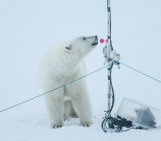
Most of the time when we speak or read about sea ice it is probably about its extent or thickness or the decline in both, or maybe even about the microorganisms living inside and underneath it. How sea ice breaks and deforms is normally not so much the topic of general discussions. This is actually a really important process that we do not know enough about, at the same time it is pretty complicated to model. Today, we would like to recommend a paper to you that is speaking about exactly that – how sea ice breaks.
First you might wonder, what it even means that sea ice breaks and why it is so important?
When sea ice breaks we are speaking of deformation, which mainly means that sea ice can actually break and form cracks of open water or it is being pushed together and forms ridges. Both features are important components of the Arctic Ocean’s climate and ecosystem. Cracks in the sea ice form open water areas (so called leads) which impact the Ocean’s heat exchange, while ridges can form new habitats and wind protections. When looking at Figure 1 we can get an idea how different it can look, when sea ice is deforming, it can do that in all kinds of ways and especially along different angles. These different angles, you guessed right, make it even harder to model these processes of sea ice deformation which is again crucial for understanding them and their impacts on the polar climate. Additionally it is extremely important for weather prediction and marine navigation, that these patterns of deformation are represented accurately in models. In their recent publication Ringeisen et al. (2023) are introducing an approach in improving the ways of modeling sea ice deformation.
Let’s dive a bit deeper into the matter of sea ice deformation and read what the authors of today’s highlighted paper tell us about how, when sea ice deforms, small angles are more common than large angles.
“Sea ice breaks along long, elongated structures, called ridges and leads. How the ice breaks, in particular the angle between different ridges and leads, can tell us a lot about the ice’s mechanics, a property still poorly represented in sea ice models. In our study, we systematically observed a maximum of intersection angles in Arctic sea ice (8186 angles to be exact) using two satellite-derived sea ice deformation datasets covering a large region and a long time span. We observe that small acute angles are much more common than large angles, agreeing almost perfectly. The mechanics derived from the observed angles allow us to propose improvements to a mechanical property of sea ice models called the yield curve, which may lead to better representation of sea ice ridges and leads in the future, with more small angles and less large angles.”
If you are into sea ice deformation and sea ice modeling, we highly recommend you to give it a read, but also if you are not, don’t be scared of the technical part of this paper and try reading it.
Finally, here is another cool fact about this paper: it was entirely designed and written by early career researchers. So if you develop a cool idea with your peers, don’t hesitate to follow it, it might lead to a publication.
Further reads
- Read the original publication: Ringeisen et al. (2023) “Deformation lines in Arctic sea ice: intersection angle distribution and mechanical properties”
- I am fascinated by sea ice and wrote a post before about why we should care sea ice
- A blog post about the role of cracks (leads) for sea ice production
- A blog post about another highlighted paper from earlier this year about sea ice production – “The ice factories of the Arctic Ocean”
- A blog post about the secrets of sea ice in winter
- A blog post on modeling the “Future of Arctic sea ice”
edited by Maria Scheel
 Lina Madaj is a postdoctoral researcher at the Vrije Universiteit Amsterdam in the Netherlands. Her research focusses on coastal erosion along the Canadian Beaufort Sea Coast and the fate of organic carbon discharge into the ocean through thawing permafrost. A side project of hers is investigating the impacts of increased sediment input into Tuktoyaktuk Harbour. She is one of the chief editors of this blog and tweets as @Oktopus_76N
Lina Madaj is a postdoctoral researcher at the Vrije Universiteit Amsterdam in the Netherlands. Her research focusses on coastal erosion along the Canadian Beaufort Sea Coast and the fate of organic carbon discharge into the ocean through thawing permafrost. A side project of hers is investigating the impacts of increased sediment input into Tuktoyaktuk Harbour. She is one of the chief editors of this blog and tweets as @Oktopus_76N
Contact email: l.madaj@vu.nl




